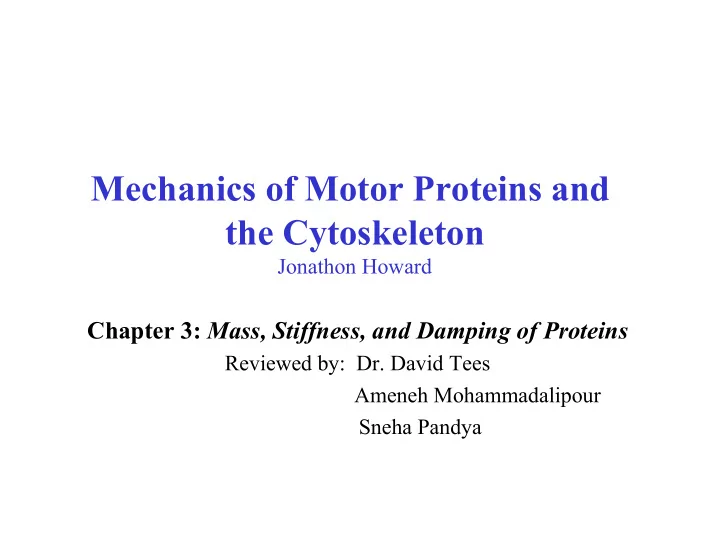

Mechanics of Motor Proteins and the Cytoskeleton Jonathon Howard Chapter 3: Mass, Stiffness, and Damping of Proteins Reviewed by: Dr. David Tees Ameneh Mohammadalipour Sneha Pandya
Outline Purpose: • What proteins are like as mechanical devices. • How rigid they are. • How quickly they move and change shape. • What is the quality of their motion. • … We need to know: • Material properties of protein; density, elasticity …. • Frictional forces that damp their motion. Summary: • Proteins have similar densities and rigidities to hard plastics and Plexiglas. • Because of their small sizes, the viscous forces from the surrounding fluid are large, compared to their inertial forces. • The motion of proteins are overdamped: they relax monotonically into new conformations.
Mass m = ρ V Molecular Mass (Da): The mass in grams of a mole of the molecules. 1 Da= 1.66 × 10 -27 kg Average density= 1.38 × 10 3 kg/m 3 Alberts et al, Molecular Biology of the Cell, 2002.
Elasticity A solid is homogenous if its mechanical properties are identical throughout, and it is isotropic if these properties do not depend on direction. F = κ Δ L stiffness F A = E Δ L Strain L (relative length Stress Young’s change) (pressure) modulus
Examples of Tensile Stress Young’s modulus is independent of size and shape Stiffness depends on size, shape and Young’s modulus ⎫ F = κ Δ L ⇒ κ = F ⎪ ⇒ κ = EA Δ L ⎬ F A = E Δ L L ⇒ F Δ L = EA L ⎪ ⎭ L To solve the small- angle equation: ⎫ d 2 y dx 2 = M ( x ) EI ( Lx 2 2 − x 3 ⎪ ⇒ y ( x ) = F ⎬ 6 ) EI ⎪ M ( x ) = F ( L − x ) ⎭ Bending moment second moment y ( L ) = FL 3 ⎫ y ( L ) = 3 EI F 3 EI ⇒ κ = ⎪ Er 4 ⎪ L 3 ⇒ κ = 3 π ⎬ L 3 4 I = π ⎪ 4 r 4 ⎪ ⎭
Shear Modulus F A = G θ shear modulus: G = E /2(1 + σ ) Δ w w = σ Δ L Poisson’s ratio L (-1 ≤σ≤ 0.5) Incompressible: G = E /3 A homogeneous and isotopic material has two elastic parameters: - Young’s modulus - Poisson's ratio
The Molecular Basis of Elasticity -Strong covalent chemical bonds: Electrostatic bonds (ion pairs and hydrogen bonds) -Weak noncovalent physical bonds: Van der repulsive, exchange energy +C/r 12 Waals bonds Lennard- Jones Potential: ⎡ ⎤ 6 12 ⎛ ⎞ ⎛ ⎞ U ( r ) = − U 0 2 r − r 0 0 ⎢ ⎜ ⎟ ⎜ ⎟ ⎥ ⎝ r ⎠ ⎝ r ⎠ ⎣ ⎦ attractive, At the bottom of the well: dispersion energy –C/r 6 U ( r ) ≅ U 0 + 1 0 ) 2 2 κ ( r − r Bond energy Stiffness of the bond Required force to stretch the bond a small distance (r-r 0 ): : Hooke’s law F ( r ) = dU / dr ≅ κ ( r − r 0 )
Models of Materials ⎫ F = κ Δ r ⇒ F Δ r 2 = κ ⎪ ⎪ r r r 0 0 0 ⎬ ⇒ E = κ / r 0 F A = E Δ L ⎪ ⎪ ⎭ L Rigidity of proteins is primarily limited by the rigidity of the van der Waals bonds.
Viscous Damping Solvent friction: From the viscosity of the surrounding fluid Two damping forces: Protein friction: From transitory interactions between amino acids that slide with respect to one another as the protein changes shape. Newton’s Law of Viscosity: F A = η dv dx Shear rate (velocity applied stress gradient) Viscosity (Pa.s) (pressure)
Newtonian and Non-Newtonian fluids Newtonian fluid: viscosity is independent of the velocity gradient Non-Newtonian fluid: viscosity dependents on the velocity gradient Shear Thinning: – High molecular weight (polymers) – Higher shear rate aligns molecules and viscosity decreases Shear Thickening: – Large particles suspended in smaller particles – Higher shear rate pushes out smaller molecules and viscosity increases
Reynolds Number Te drag force on object depends on the pattern of the fluid flow around the object: - Laminar flow - Turbulent flow Characteristic length of the object Reynolds number=inertial Density of the liquid forces/viscous forces Speed of the Re = ρ Lv object η viscosity At low Reynolds numbers (Re<1), the drag force is proportional to the speed: : F d = − γ v = − 6 πη rv Stokes’ law γ = 6 πη r Drag force for a sphere of Coefficient of viscosity: radius r, moving at constant velocity v
Recommend
More recommend